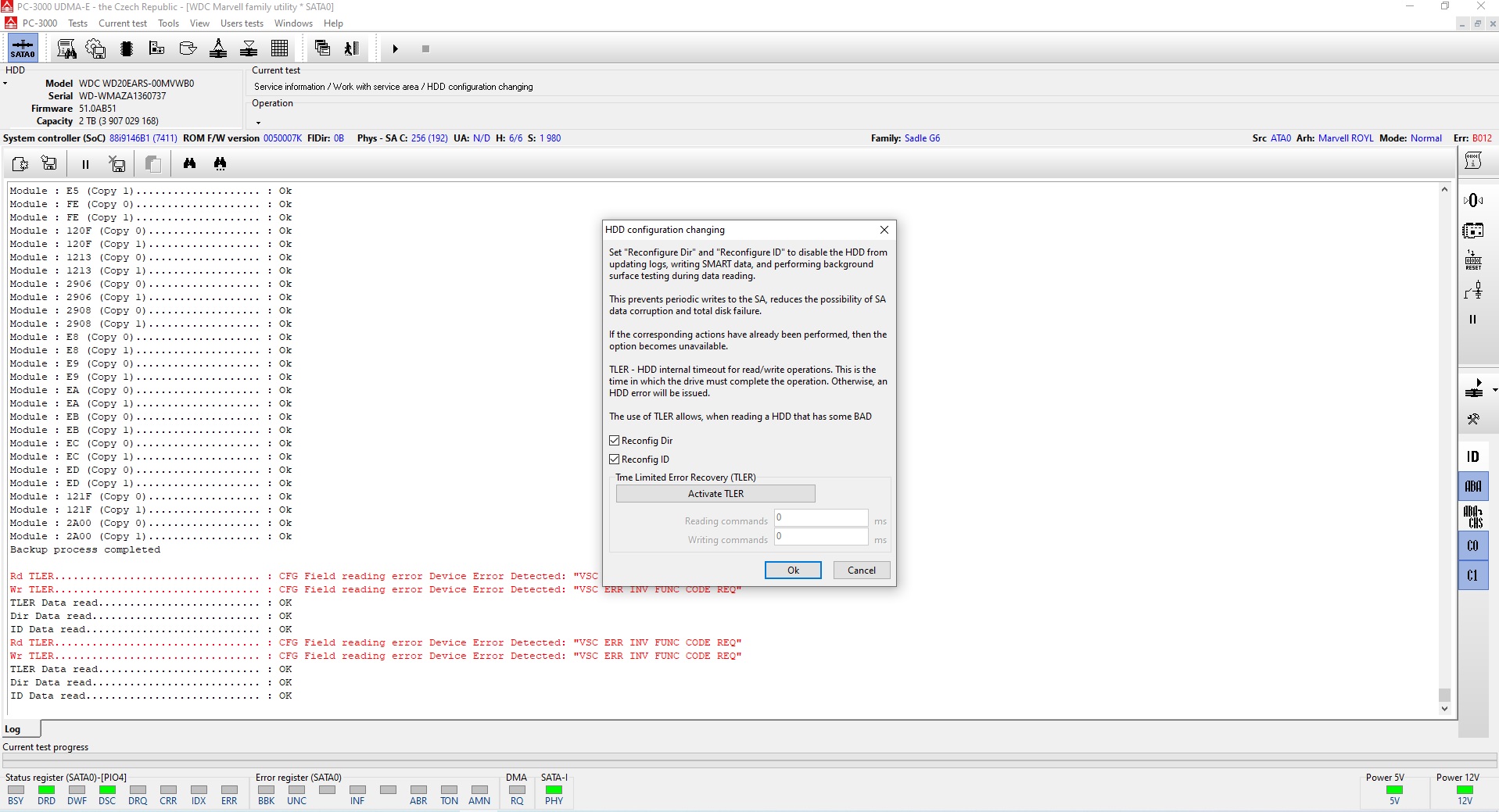Bad sectors may appear because of the bad quality of the heads or due to small scratches on the surface of the platters. This problem is pretty up-to-date and sometimes, when you don’t have an opportunity to replace the heads or open the HDA on the Hard Drive, the only way to get the data is to be patient and reread all bad sectors one by one with different time-out settings in the Data Extractor.
But what to do if the WD disks have a lot of BAD sectors, and it is necessary to force the disk to complete the image?
First of all, we need to understand how the default WD Firmware processes the errors. Usually, it takes a few steps:
- Reading attempt of the “X LBA” with a default timeout
- In case of timeout limits excess, rereading the same LBA a dozen times during a few seconds
- Software/hardware reset
- Recalibration of the heads
- Another reading attempt of the “X+1 LBA”…
- In the background: writing error logs inside the SA area
This is a default error processing scenario on WD drives which sometimes may take too long to reread most of the BAD sectors on some critical areas like MFT map. Another problem is related to safe data reading. Background log writing may make the drive work worse or even kill the unstable HDD.
ACE Lab engineers found an efficient and interesting feature inside the WD firmware which is called TLER – Time-Limited Error Recovery. We already talked about it during the December 2021 Webinar about the new features of the Western Digital Utility in PC-3000.
This feature allows to:
- reduce the time for error processing and set your own internal HDD timeout
- disable all non-critical SA modules
- switch off all background processes
- make fast and effective BAD sectors reading and processing
And what is very important, it completely disables ALL background operations on the HDD. It makes the rereading and copying process safe for the hard disk drive.
The new feature is compatible with more or less modern WD HDDs. It’s safe for drive copying and it can be a perfect solution for cases when the head swap is not possible.
The TLER feature is available only on the new x86 and x64 versions of PC-3000 7.0.x in the PC-3000 HDD product line: PC-3000 Express, UDMA and Portable III.
Let’s consider in practice how to work with the TLER feature. We received a WDC WD20EARS-00MVWB0 2 TB, with reading problems with one of the heads, the ID is full, the registers are in the ready state.
Let’s initialize the HDD in the WD Marvell Utility and go to the Data Extractor to build a heads map and start the process of creating a copy.
In the process of creating a copy, when reading head 4, we see how the behaviour of the disk changes. It starts to emit scratching sounds, knocks when trying to read the next bad sector, there is a constant recalibration of the heads, the registers go to the error state, the software reset processing of each bad block takes several seconds.
This is a great example of when the TLER feature can be useful.
But before we activate it, please remember to make a resources backup!
When the backup process is over, we can try to activate the TLER feature.
To activate it, let’s go to the WD Utility and choose the following path:
Test → Service information → Work with service area → HDD configuration changing.
HDD configuration changing:
Press the button: ‘Activate TLER’:
Press the button ‘Yes‘:
TLER is activated:
In the window that appears, we are asked to set a timeout for bad sectors:
Active Сheckboxes “Reconfig Dir” and “Recongig ID”– Allow you to disable some of the unimportant modules in the HDD SA. As a result, the reliability during data reading from the surface will increase. Moreover, these checkboxes will block any log writing inside the drive SA which prevents the further possible heads degradation.
Set the default values:
Reading commands: 200-300 ms;
Writing commands: 200-300 ms;
and click ‘OK‘
After executing TLER, we see in the program log that the value of active modules has changed (from 415 to 161):
Update the disk information in the Utility status:
Now we can return to the Data Extractor again and see how the WD drive will read BADs after the TLER method (time-limited error recovery):
As we can see, reading BAD sectors has become much faster. We do not reread the same BAD sector several times damaging the surface of the plate even more. Of course, the TLER method will not replace the head swap method. The TLER method can be used in cases when it is not possible to find a disk donor or there is no clean room or the bad sectors can’t be fixed due to the HDD surface partial corruption.
Final comparison:

Without TLER

With the active TLER command




























Thanks Ace Lab, this is the best feature I have found in PC3000 for Data recovery of WD drives with severe bad sectors.
Thank you! 🙂 The next step – is adding something similar to Seagate and Toshiba. ACE Lab devs are researching it.